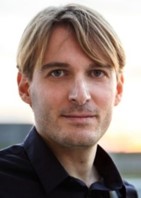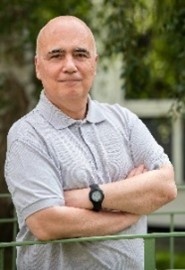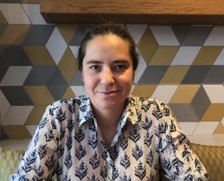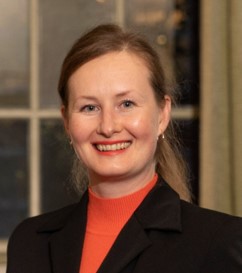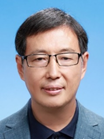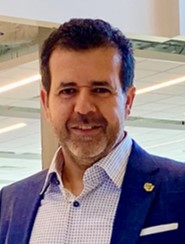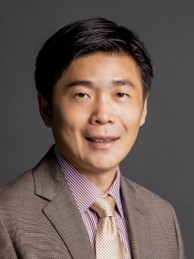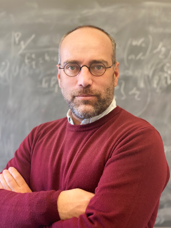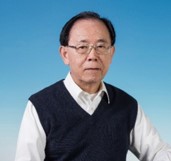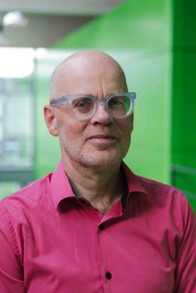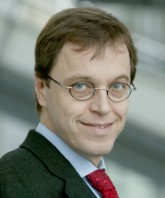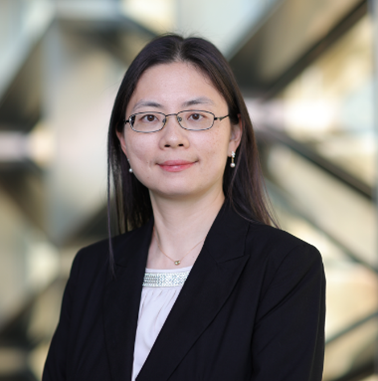
|
|
|
Keynote talksKeynote Speakers:
Detailed Keynote Talks: --------------------------------------------------------------------------------------------------------------------------------------------------------------------------
Andrea Alù on "Topology and duality in acoustic metamaterials" Abstract: In this talk, I discuss our recent efforts in the context of acoustic and mechanical metamaterials featuring topological features driven by broken symmetries. Among the wave phenomena I will discuss, I will report the first demonstration of hyperbolic wave attractors in odd-shaped cavities supporting hyperbolic acoustic waves, and the emergence of topological phenomena based on hidden symmetries in acoustic metamaterials. Biography: Andrea Alù is a Distinguished Professor at the City University of New York (CUNY), the Founding Director of the Photonics Initiative at the CUNY Advanced Science Research Center, and the Einstein Professor of Physics at the CUNY Graduate Center. He received his Laurea (2001) and PhD (2007) from the University of Roma Tre, Italy, and, after a postdoc at the University of Pennsylvania, he joined the faculty of the University of Texas at Austin in 2009, where he was the Temple Foundation Endowed Professor until Jan. 2018. Dr. Alù is a Fellow of the National Academy of Inventors (NAI), the American Association for the Advancement of Science (AAAS), the Institute of Electrical and Electronic Engineers (IEEE), the Materials Research Society (MRS), Optica, the International Society for Optics and Photonics (SPIE) and the American Physical Society (APS). He is a Highly Cited Researcher since 2017, a Simons Investigator in Physics, the director of the Simons Collaboration on Extreme Wave Phenomena Based on Symmetries, and the Editor in Chief of Optical Materials Express. He has received several scientific awards, including the NSF Alan T. Waterman award, the Blavatnik National Award for Physical Sciences and Engineering, the IEEE Kiyo Tomiyasu Award, the ICO Prize in Optics, the Optica Max Born Award, the SPIE Mozi Award and the URSI Issac Koga Gold Medal. ------------------------------------------------------------------------------------------------------------------------------------------------------------------
Davide Bigoni: Stable and unstable metamaterials Biography: Davide Bigoni graduated from the University of Bologna (Italy), where he completed his Ph.D. in 1991 under the supervision of Professor T. Hueckel (Duke University, USA). He began his academic career as an Assistant Professor at the University of Bologna and, in 1999, became an Associate Professor at the University of Trento (Italy). Since 2001, Professor Bigoni has held a Full Professor position at the University of Trento, where he leads a dynamic research group specializing in Solid and Structural Mechanics. His recognitions include being elected a Euromech Fellow by the European Mechanics Society in 2009, receiving the Ceramic Technology Transfer Day Award in 2012, and being awarded a Doctor Honoris Causa by Ovidius University of Constanta in 2014. Additionally, he has been honored with the Panetti and Ferrari Award for Applied Mechanics by the Accademia delle Scienze di Torino. His contributions extend globally: he was the Guest Lecturer for the Midwest Mechanics Seminars in 2018, elected a Fellow of the Istituto Lombardo, Accademia di Scienze e Lettere in 2019, and featured in a 60th Anniversary Issue of the Journal of the Mechanics and Physics of Solids. In 2024, he was inducted as a Fellow of the Italian Academy of Engineering. Professor Bigoni’s research is prominently featured on the covers of nine international journals. He has played a key role in fostering academia-industry collaboration, coordinating three European grants and a Marie Curie Fellowship. He is the recipient of two prestigious ERC Advanced Grants from the European Research Council (2013, 2021). More details can be found at https://bigoni.dicam.unitn.it/
------------------------------------------------------------------------------------------------------------------------------------------------------------------  Johan Christensen on "Buckle-Barrel Correspondence in Mechanical Metamaterials"
Abstract: Harnessing instabilities in architected lattices and metamaterials allows for controlled nonlinear deformations, enabling desired mechanical functions like shape morphing and energy absorption. By precisely tailoring instabilities such as buckling into the structure, deformations become a powerful instrument rather than a failure mode, offering new possibilities for predictable responses to mechanical loads. Inspired by the bulk-boundary correspondence in condensed matter physics, an analogous relationship is explored in metamaterials, where the underlying topology dictates whether the structure under load buckles or barrels. The underlying mechanism that originates from a polarization conversion in the elementary beam network is discussed. Moreover, these predictions, which can be extended to more complex topologies and higher dimensions, showcase that a mode inversion process governs both global deformations and the orientation of localized shear strains within the bulk. It is anticipated that the buckle-barrel correspondence can be extended to non-Hookean materials, paving the way for predicting the onset and evolution of true failure.
Biography: Johan Christensen is a research Professor at the Madrid Institute for Advanced Studies (IMDEA). He is interested in wave physics and the theoretical description and numerical modelling of acoustic and mechanical metamaterials and topological insulators. In 2010, he was awarded his PhD at the Autonomous University of Madrid. He obtained various awards and grants including a Marie-Curie Doctorate fellowship, two Carlsberg fellowships, the Young Elite Researcher Prize from the Danish Research Council, and a Ramon y Cajal fellowship. In 2016 he received a Starting Grant from the European Research Council, which aims to support promising up-and-coming research leaders in Europe. In 2019 he received the Phononics Young Investigator award from the International Phononics Society.
--------------------------------------------------------------------------------------------------------------------------------------------------------------------------
Laure Giovangigli on "Scattering by a random thin coating of nanoparticles" Abstract: We study in this talk the time-harmonic scattering by a heterogeneous object covered with a thin layer of randomly distributed nanoparticles. The goal is to quantify the impact of this coating on the scattered wave. The size of the particles, their distance between each other and the thickness of the layer are all of the same order but small compared to the wavelength of the incident wave. Solving numerically Maxwell’s equations in this context is very costly. Moreover the distribution of particles on a given object is unknown. To circumvent these difficulties, we propose via a multi-scale asymptotic expansion of the solution, an effective model where the layer of particles and the object are replaced by an equivalent boundary condition. The coefficients in this equivalent boundary condition depend on solutions to corrector problems of Laplace-type defined on unbounded random domains. We prove that those problems are well-posed under the assumption that the particles are distributed given a stationary mixing random point process. We then establish quantitative error estimates for the effective model and present numerical simulations that illustrate our theoretical results. This work is a joint work with Sonia Fliss (ENSTA). Biography: Laure Giovangigli is an Associate Professor of Mathematics at ENSTA in Palaiseau, France. She is moreover a member of the lab POEMS. Her research focuses on wave propagation in random media with applications in inverse problems, medical imaging and meta-materials. Her interest lies in particular in multi-scale problems that require the application of stochastic homogenization techniques. Her work combines both theoretical aspects like the asymptotic analysis of solutions of PDEs and the derivation of error estimates and numerical aspects. --------------------------------------------------------------------------------------------------------------------------------------------------------------------------
Anastasiia Krushynska on “Mechanical metamaterials for implants: from design to clinical application” Abstract: We will present the design, manufacturing, testing and clinical translation of additively manufactured metamaterial implants for craniofacial reconstruction in head and neck cancer patients. Based on measured bite forces, the implants are made from clinically approved materials and currently undergo (pre)clinical trials that makes them first clinically relevant, patient-specific metamaterial implants. We also propose a mathematical framework based on generalized continuum models for computationally efficient analysis of (bio)mechanical response and optimization of the implant’s topology. Biography: Anastasiia Krushynska is an adjunct professor in wave dynamics and materials engineering at the Faculty of Science and Engineering of the University of Groningen, The Netherlands. She leads a Metamechanics Group that focuses on fundamental relations between materials and their structure and develops metamaterials for medical applications, sound insulation, vibration mitigation, and robotics. The group research activities are supported by Nationa Dutch Council grants, including NWO Open Science M, NWO KIC MetaFlow, NWO NWA-ORC ABEL, HTSM MutePipe, and European grants SNN Impact Implants and DigiArgo funding. Prof. Krushynska published more than 50 papers in leading journals, including Matter, Advanced Functional Materials, Physical Review Letters, Journal of Mechanics and Physics of Solids, New Journals of Physics, etc. with some of them highlighted in news. She serves as committee member and external evaluator for seven international funding agencies and as a referee for 70+ research journals. --------------------------------------------------------------------------------------------------------------------------------------------------------------------------
Gengkai Hu on "Rayleigh Waves in 2D Extremal Materials" Biography: Gengkai Hu is a chair professor at Beijing Institute of Technology. His research focuses on micromechanics of composites including metamaterials. He has published in JMPS, AM and many other scientific journals and has experience in sound and vibration control.
------------------------------------------------------------------------------------------------------------------------------
Mahmoud I. Hussein on "Phononic subsurfaces: Flow control by wave synchronization across the fluid-structure interface" Abstract: Fluid-structure interaction is a dynamical process that is central to managing skin-friction drag, flow transition, and flow separation in air, sea, and land vehicles, as well as in other applications like turbomachinery. The magnitude of skin-friction drag, particularly for streamlined bodies, is a key factor in determining fuel efficiency—lower drag results in higher efficiency. A significant reduction in skin- friction drag can be achieved by delaying the transition from laminar to turbulent flow. Meanwhile, flow separation significantly influences aerodynamic and hydrodynamic stability, form drag, vehicle maneuverability, and applications requiring turbulent mixing. Minimizing or delaying these effects are therefore primary objectives in flow control. Both these fundamental flow transformations are tied directly with the behavior of unstable flow disturbances, or perturbations, that occur naturally in a flow. Among the most studied are Tollmien–Schlichting waves. The linear modal nature of these waves provides an opportunity to apply phased control to suppress or enhance their growth by wave coupling and interference. Phononic subsurfaces (PSubs) is a technology that aims to passively and mechanistically intervene with these perturbations to enable either stabilization or destabilization as desired [1]. A PSub comprises a synthetically designed architected material affixed beneath the surface exposed to the flow (e.g., of a wing or vehicle body). The function of the PSub is to manipulate small-amplitude vibrations on the surface, and by extension the flow perturbations near the wall. A PSub material and geometric architecture can be selected to function as a phononic crystal that exhibits Bragg scattering [1,2], or a locally resonant elastic metamaterial that exhibits resonance hybridizations [3,4]. In either case, the phononic material is truncated and finite-size structural effects must be considered in the design alongside the unit-cell topology. PSubs may be tailored to passively respond to the flow instabilities in an out-of-phase manner creating anti-resonance conditions in both the structure and the flow which lead to stabilization, or in an in-phase manner creating resonance conditions and destabilization. In this talk, a series of latest developments in PSubs research will be overviewed, including utilization of PSubs for downstream control [5] and their design to impede perturbation waves over a broad frequency range. [1] Hussein, M.I., Biringen, S., Bilal, O.R., and Kucala, A. “Flow stabilization by subsurface phonons,” Proceedings of the Royal Society A 471, 20140928, 2015. Bibliography: Mahmoud I. Hussein is the Alvah and Harriet Hovlid Professor at the Smead Department of Aerospace Engineering Sciences at the University of Colorado Boulder. He holds a courtesy faculty appointment in the Department of Physics and has previously served as the Engineering Faculty Director of the Pre-Engineering Program and the Program of Exploratory Studies. He received a BS degree from the American University in Cairo (1994) and MS degrees from Imperial College London (1995) and the University of Michigan‒Ann Arbor (1999, 2002). In 2004, he received a PhD degree from the University of Michigan‒Ann Arbor, after which he spent two years at the University of Cambridge as a postdoctoral research associate. Dr. Hussein’s research focuses on the dynamics of materials and structures, especially phononic crystals and metamaterials, at both the continuum and atomistic scales. He received a DARPA Young Faculty Award in 2011, an NSF CAREER award in 2013, and in 2017 was honored with a Provost’s Faculty Achievement Award for Tenured Faculty at CU Boulder. He was awarded as PI two large-scale grants, both on concepts he discovered—nanophononic metamaterials (NPMs, Phys. Rev. Lett., 2014; ARPA-E, $3 million, 2019-2023) and phononic subsurface (PSubs, Proc. R. Soc. A, 2015; ONR MURI, $7.5 million, 2024-2029). He has co-edited a book titled Dynamics of Lattice Materials published by Wiley. He is a Fellow of ASME and has served as an associate editor for the ASME Journal of Vibration and Acoustics. In addition, he is the founding vice president of the International Phononics Society and has co-established the biennial Phononics 20xx conference series which has helped create a new multidisciplinary research community and is widely viewed as the world’s premier event in the emerging field of phononics. ---------------------------------------------------------------------------------------------------------------------------------------------------------------------------
Cheng-Wei Qiu on "When heat transfer meets metamaterials and topological physics" Abstract: The well-known three modes of heat transfer, including conduction, convection, and radiation, pave the way of flexibly controlling thermal distributions by varied implementations, thus further contributing to the emerging thermal time-varying metamaterials. In this talk, we will introduce new developments of hybrid thermal materials with artificial meta-structures to realize extremely high effective thermal conduction. We will also introduce our more recent breakthrough in topological thermal materials by constructing an orthogonal convective space with two pairs of counter-motion convections for encircling exceptional points (EPs). Configurable phase transitions were subsequently demonstrated by adjusting the EP quantities in the orthogonal convective space. Further, we report the realization of Weyl exceptional ring in thermal diffusion by using two pairs of spatiotemporal advections to obtain three imitated dimensions. The spatiotemporal thermal coupling can give rise to diffusive Fizeau drag, which features different speeds of temperature field propagation in opposite directions. We further tailor the modulated Hermiticity in both space and time, and establish an advective paradigm by periodically stacked fluid surfaces. Topological edge and conventional bulk states, as well as interface states and topological manipulations, are revealed in thermal diffusion for the first time. Those works pave the foundation of the area of topological thermal metamaterials. Biography: Prof. Cheng-Wei Qiu is Provost’s Chair Professor in National University of Singapore, NUS. He is Fellow of Academy of Engineering, Singapore. He is Foreign Fellow of Chinese Optical Society, Fellow of APS, Optica, SPIE and The Electromagnetics Academy, US. He was the recipient of President’s Science Award 2023, the highest science accolade in Singapore. He was elected Fellow of ASEAN Academy of Engineering and Technology. He is well known for his research in structured light and interfaces. He has published over 580 peer-reviewed journal papers. He was the recipient of URSI Young Scientist Award in 2008, NUS Young Investigator Award in 2011, MIT TR35@Singapore Award in 2012, Young Scientist Award by Singapore National Academy of Science in 2013, Faculty Young Research Award in NUS 2013, SPIE Rising Researcher Award 2018, Young Engineering Research Award 2018, and Engineering Researcher Award 2021 in NUS, and World Scientific Medal 2021 by Institute of Physics, Singapore, Achievement in Asia Award (Robert T. Poe Prize) by International Organization of Chinese Physicists and Astronomers in 2022. He was Highly Cited Researchers in 2019-2024 by Web of Science. He has been serving in Associate Editor for various journals such as JOSA B, PhotoniX, Photonics Research, and Editor-in-Chief for eLight (IF: 31.2). He also serves in Editorial Advisory Board for Laser and Photonics Review, Advanced Optical Materials, and ACS Photonics.
---------------------------------------------------------------------------------------------------------------------------------------------------------------------------
Vincent Tournat on "Waves in Multistable Mechanical Metamaterials" Abstract: Multistable metamaterials, composed for example of bistable mechanical units elastically coupled to their nearest neighbors, have recently been conceived in diverse ways, particularly within the family of flexible mechanical metamaterial architectures. Such multistable metamaterials can support progressive fronts, also called transition waves, switching sequentially its multistable units front one equilibrium to another, and resulting in the local or global reconfiguration of the medium. In addition, these nonlinear metamaterials are also known to support a rich variety of nonlinear waves, as vector solitons, breathers, cnoidal waves, among others. In this presentation, I will highlight the fundamentals and a selection of recent results on transition waves triggering, propagation, and discuss some of their potential applications. In general, these reconfiguration fronts obey nonlinear reaction-diffusion equations and show specific properties not necessarily found in other waves supported by periodic and/or nonlinear media, e.g., strong nonreciprocity, robustness, extreme amplitude dependent behavior… They can consequently be implemented for applications involving local or global reconfiguration of a medium, manipulating mechanical memory, controlling waves in space and time, mechanical computing or be the vector for material embedded intelligence.
Biography: Vincent Tournat currently holds a Research Professor position at CNRS and conducts research in the field of nonlinear waves and metamaterials at the Laboratory of Acoustics at Le Mans University in France. VT graduated with a major in solid state physics, acoustics & wave physics and defended his PhD thesis on nonlinear acoustics in granular materials in 2003. He then spent the year 2004 as a postdoc at Hokkaido University, Japan, working on laser picosecond ultrasonics, prior to starting at CNRS. During his first years at CNRS, he established two research groups on acoustics of granular media and laser ultrasonics, then participated in developing two other areas of research in his department, ultrasonic non-destructive testing, and acoustic metamaterials. For the last decade, his research focuses on nonlinear waves in flexible mechanical metamaterials. From 2007 to 2022, VT led the "Acoustics and Mechanics of Materials" research team of more than 50 people. His research achievements have been awarded prizes on several occasions, including the CNRS Bronze Medal in 2010 and the Silver Whistle early career award by the International Commission on Ultrasonics (ICU) in 2013. Until 2024, he has been the director of the Institut d’Acoustique - Graduate School (http://iags.univ-lemans.fr) created in 2017 and awarded the national label “Graduate School” (a selection of few Institutes comprising high impact research laboratories, departments, as well as recognized master, engineering and doctoral curriculae). VT has been regularly invited for research visits in Japan, Chile, Spain, USA and he is a visiting research Professor at Harvard University since September 2022. https://perso.univ-lemans.fr/~vtournat/ ---------------------------------------------------------------------------------------------------------------------------------------------------------------------------
Ping Sheng on "The Mosaic Approach to Acoustic Metamaterials Design" Abstract: The mosaic approach denotes the use of finite-sized pieces, with their distinct responses to external excitations from bulk materials, as the basic elements in forming a mosaic metamaterial sample that can display characteristics not found in uniform materials. In this article we present three examples of the mosaic design approach to illustrate the potential of extending the functionalites of acoustic metamaterial. Biography: Ping Sheng is a senior member of the Institute for Advanced Study and Professor Emeritus at HKUST. He obtained his BSc in Physics from the California Institute of Technology, and PhD in Physics from Princeton University in 1971. After a stay at the Institute for Advanced Study, Ping joined RCA David Sarnoff Research Center in 1973. In 1979 he joined the Exxon Corporate Research Lab, where he served as the head of the theory group during 1982-86. In 1994 Ping joined the HKUST as a professor of physics and served as the head of the physics department from 1999 to 2008. Prof. Sheng is a Fellow of the American Physical Society and a Member of the Asia Pacific Academy of Materials. He served as the Executive Editor of Solid State Communications, a Division Associate Editor of Physical Review Letters and a member of the editorial board of New Journal of Physics. He was awarded the Brillouin Medal by the International Phononics Society in 2013, the Rolf Landauer Medal by the ETOPIM Society in 2018, and the Bloch Prize in 2021. Prof. Sheng was elected a member of the Hong Kong Academy of Sciences in 2019. Prof. Sheng has published more than 480 papers with a total of over 52,000 citations, with an h-index of 101 (by Google Scholar). He has presented over 350 keynote, plenary or invited talks at international meetings and conferences. His research interests include acoustic metamaterials, nanostructured carbon, giant electrorheological fluids, fluid-solid interfacial phenomena, and effective medium theory of composites. Prof. Sheng’s research has led to the founding of a successful startup company, the Acoustic Metamaterials Group, which is in the process of establishing a base in the UK. --------------------------------------------------------------------------------------------------------------------------------
Martin Van Hecke on "Massively Multistable Metamaterials" Abstract: Uniting many bistable units into a single entity produces massively multistable metamaterials, that open new routes to store and process information, shapes, and material properties. Biography: Martin van Hecke is a group leader at AMOLF, Amsterdam, and a professor of physics at Leiden University. He works on flexible and frustrated matter, combining experiments, simulations and theory. In the past decade he developed programmable, shape-shifting and self-folding metamaterials which straddle the boundary between material and machine. He is currently exploring how multistable materials, from metamaterials to crumpled sheets can be understood from the perspective of information processing.
-------------------------------------------------------------------------------------------------------------------------------
Martin Wegener on "Nonlocality as a design tool in wave-tape and diffusion-type metamaterials” Abstract: We review our theoretical and experimental work on using nonlocal interactions in metamaterials as a design tool to engineer targeted dynamic and static behavior in wave-type systems as well as in diffusion-type systems. For example, nonlocality allows to achieve large characteristic lengths connected with anomalous size effects in elasticity beyond Cauchy elasticity. Designed nonlocal interactions can also lead to any wanted nonlocal diffusivity (or conductivity) in, e.g., static and dynamic charge flow, fluid flow, and the flow of thermal energy (thermal conduction). Bibliography: After completing his Diplom and PhD in physics at Johann Wolfgang Goethe-Universität Frankfurt (Germany) in 1986 and 1987, respectively, he spent two years as a postdoc at AT&T Bell Laboratories in Holmdel (U.S.A.). From 1990-1995 he was professor (C3) at Universität Dortmund (Germany), since 1995 he is professor (C4, later W3) at Institute of Applied Physics of Karlsruhe Institute of Technology (KIT). Since 2001 he has a joint appointment as department head at Institute of Nanotechnology (INT) of KIT, from 2016-2022 he was one of three directors at INT. From 2001-2014 he was the coordinator of the DFG-Center for Functional Nanostructures (CFN) at KIT. Since 2018 he is spokesperson of the Cluster of Excellence 3D Matter Made to Order. His research interests comprise ultrafast optics, (extreme) nonlinear optics, optical laser lithography, photonic crystals, optical, mechanical, electronic, and thermodynamic metamaterials, as well as transformation physics. This research has led to various awards and honors, among which are the Alfried Krupp von Bohlen und Halbach Research Award 1993, the Baden-Württemberg Teaching Award 1998, the DFG Gottfried Wilhelm Leibniz Award 2000, the European Union René Descartes Prize 2005, the Baden-Württemberg Research Award 2005, the Carl Zeiss Research Award 2006, the Hector Research Award 2008, the SPIE Prism Award 2014 for the start-up company Nanoscribe GmbH, the Stifterverband Science Award – Erwin-Schrödinger Prize 2016, and the Technology Transfer Prize of the German Physical Society (DPG) 2018. In 2014, 2015, 2016, 2017, 2018, 2020, and 2021 Clarivate Analytics listed him as “Highly Cited Researcher” (top 1%). He is Member of Leopoldina, the German Academy of Sciences (since 2006), Member of acatech, the National Academy of Science and Engineering (since 2019), Member of the Hector Fellow Academy (since 2013, President from 2016-2022), Fellow of the Max Planck School of Photonics (since 2019), Fellow of the Optical Society of America (since 2008), and Honorary Professor at Huazhong University of Science & Technology, Wuhan, China (since 2014). -------------------------------------------------------------------------------------------------------------------------------- Michael I. Weinstein on Mathematics of Magnetic and Pseudo-magnetic Fields in Quantum and Classical Wave Systems --------------------------------------------------------------------------------------------------------------------------------------------------------------------------
Ying Wu on "Effective medium theories and their applications in metamaterials" Biography: Ying Wu is Professor and Chair of Applied Mathematics and Computational Science (AMCS) at King Abdullah University of Science and Technology (KAUST). Her research focuses on the theoretical and numerical modeling of metamaterials, with expertise spanning homogenization, coupled-mode theory, perturbation methods, and multiple
|
